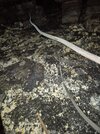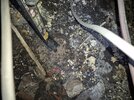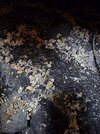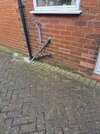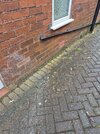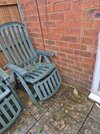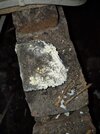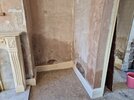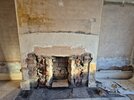I have a subfloor void in a room which has a unused fireplace of a 1930s semi in the north west of england. There is lots of white deposit on the subfloor void and when I dig the floor the ground is like clay. Is this deposit mould or salts? I cant see any on the underside of the floorboards its just on the ground?
The external walls had cavity wall insulation done back in 2007 according the 'supposed guarantee'. The vents to the subfloor appear to be full of the cavity wool stuff but there is still some airflow.
The walls holding the subfloor joist does appear to have the old dpc. Whilst the external walls which had cavity wall insulation appear damp free the internal walls especially on the chimney side which is a party wall has what appear to be rising damp up to a meter from the floor and areas where furry deposits are forming on the lime plaster.
The external floor level has also been raised very high by whoever did the paving. You can see the dpc layer is on top of the first course of bricks from the paving right along the line with the door step. I'm thinking of removing the line of block paving bricks touching the wall and diggin a trench 150mm below the dpc level, lay a geotextile membrane and back fill with pea shingle up 100mm leaving a gap of 50mm between pea shingle and dpc layer or do i need to leave a gap of 150mm between dpc and peashingle? in which case i'd need to dig 250mm trench?
Also how would i stop the edging of the blockpaving from shifting overtime?
Any advice and steps to remedy.
The external walls had cavity wall insulation done back in 2007 according the 'supposed guarantee'. The vents to the subfloor appear to be full of the cavity wool stuff but there is still some airflow.
The walls holding the subfloor joist does appear to have the old dpc. Whilst the external walls which had cavity wall insulation appear damp free the internal walls especially on the chimney side which is a party wall has what appear to be rising damp up to a meter from the floor and areas where furry deposits are forming on the lime plaster.
The external floor level has also been raised very high by whoever did the paving. You can see the dpc layer is on top of the first course of bricks from the paving right along the line with the door step. I'm thinking of removing the line of block paving bricks touching the wall and diggin a trench 150mm below the dpc level, lay a geotextile membrane and back fill with pea shingle up 100mm leaving a gap of 50mm between pea shingle and dpc layer or do i need to leave a gap of 150mm between dpc and peashingle? in which case i'd need to dig 250mm trench?
Also how would i stop the edging of the blockpaving from shifting overtime?
Any advice and steps to remedy.


